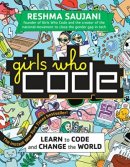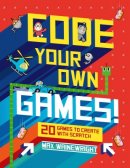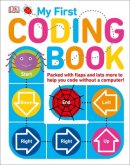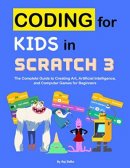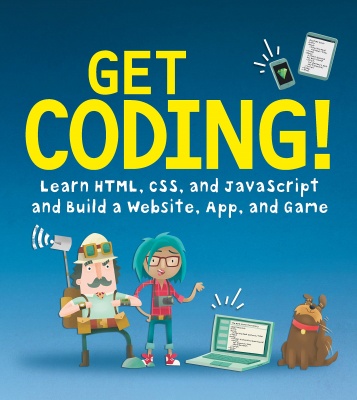10 Best Coding Books for Kids Reviewed in 2024
Because our world of high technology involves computers at almost every step, it is wise to get your kids started with coding and programming at a very early age. They begin practicing computer skills in school at the kindergarten level, so it is never too early to start at home. Kids as young as five can manipulate a keyboard to do the most basic tasks of programming and coding, so why wait? We have compiled a list of the best coding books for kids according to parent ratings.
Even though they all approach the learning of coding in different ways, these books are all engaging and fun for children with plenty of games, activities, and projects to make the education exciting. Each one is rated according to its educational value, ease of use, age range, and creativity to help you choose one or two for your child.
In a Hurry? The test winner after 35 hrs of research

For those with no or little coding experience
Instructions are simple to follow with fun graphics
Uses Scratch programming language
Make games and puzzles, animation, and mazes
Packed with many fun exercises

10 Best Coding Books for Kids Reviewed
1. Games in Scratch
For those with no or little coding experience
Instructions are simple to follow with fun graphics
Uses Scratch programming language
Make games and puzzles, animation, and mazes
Packed with many fun exercises
Instructions can be complicated in places
Information is a bit outdated
Coding Games in Scratch comes as a paperback edition written by Jon Woodcock that uses Scratch programming language to teach building computer projects.
Read moreInstructions are simple to follow with fun graphics, and there are multiplayer or single platform games. Only a laptop or desktop computer is needed and a connection for the Internet. The programming language is Scratch 2.0, which is free for anyone to use online. The Internet connection is needed for project sharing and program download only. The author has a physics degree from Oxford and a Ph.D. from London in computational astrophysics and began coding at eight-years-old.
Educational value
It teaches creative thinking, working with others, and systematic reasoning as it builds valuable skills in programming computers. These valuable life lessons are required for most of today’s schools.
Ease of use
Packed with many fun exercises, it is for the advanced beginner in the grade range of third to seventh. Kids at this age should easily understand Scratch and its many possibilities.
Creativity
Make memory games and puzzles, add animation, and dart through mazes with this 224-page volume. It will seem like all fun and games to children but the lessons they learn along the way are important.
Age range
Made for those that have no or little coding experience, such as those in the eight to twelve-year-old range, this book is a straightforward, visual guide.
2. Girls Who Code
Explains coding principles well and simply
Has amazing artwork for illustrations
Provides real-life tales of females employed in coding
How to make your own robots, games, and apps
Empowers girls and shows them how to code
Some language offended homemaker moms
Not much of actual coding instruction
Written by Reshma Saujani and available as paperback, Kindle, audio CD, and audiobook modes, Girls Who Code is best for ages ten and older and grade levels of fifth and sixth.
Read moreGirls Who Code is a real national organization that has inspired more than 40,000 young females in America. It provides real-life tales of females employed at NASA and Pixar to show how far coding can take you. It empowers girls and shows them how to code from this author that is the CEO and founder of Girls Who Code. She has had plenty of publicity from New York Daily News, Fortune, WSJ Magazine, and Business Insider concerning her skills and books written.
Educational value
Not only will girls learn to code from this product but also be inspired to greatness with real-life examples of those who have gone before them in highly important jobs that use coding.
Ease of use
This 172-page volume explains coding principles well and simply with amazing artwork for illustrations. It uses mazes, puzzles, and games to show kids the basic principles needed.
Creativity
Coding is relevant in any occupation and interest, so this wonderful book shows how to make your own robots, games, and apps to learn. With this knowledge, children can then do their own creations.
Age range
Those in the grades of fifth and sixth will reap the most benefit from this unique book aimed toward girls who want to learn to code. It teaches kids to code in a fun and progressive way.
3. DK Workbooks
Visual workbook to introduce Scratch
Includes exciting pixel artwork and simple directions
Gives hands-on experiences
Games can be used with friends to play
Provides quizzes after each project
Book can be shorter than expected
A few parents thought the information could be better
This DK Workbook of Scratch is authored by Jon Woodcock and Steve Setford and is a visual workbook to introduce the simple program of Scratch for those aged six to nine-years-old.
Read moreThe paperback edition leads the way from just playing games to eventually creating them and includes exciting pixel artwork and simple directions to cover the basic programming knowledge. It provides hands-on experiences in learning that is fun and engaging with just a laptop or desktop computer plus the Internet. The coding does not require the Internet, but the program download does. The writer has a physics degree and a computational astrophysics degree, plus gives many talks at schools about programming clubs and space.
Educational value
This terrific introductory tool to computer programming teaches creative thinking, systematic reasoning, and working with others. Coding for children does not have to be hard with the help of such books.
Ease of use
There are quizzes after each project to solidify the concepts and vocabulary in this 40-page book. It is made for the beginner and uses Scratch 2.0 program language.
Creativity
Some of the activities include a speed game, an animated bouncing melon, a ghost hunt with a flying witch, and a soccer game. Games can be used with friends to play.
Age range
Those aged six to nine will enjoy this book and the Scratch program the most. Most kids in school at this age are already experimenting with such code programs in their regular classes.
4. Code Your Own Games!
Includes twenty games for the Scratch program
Popular games of Brick Bouncer and Snake
Teaches valuable key concepts
Simple to follow and understand
Hours of fun and entertaining coding
Some wording is printed on dark blue background – hard to read
Information can be outdated
Code Your Own Games! includes twenty games that can be created with the Scratch program and comes in a hardcover edition of 80 pages. It teaches valuable key concepts and is written by Max Wainewright.
Read moreIncluded are popular games such as Brick Bouncer and Snake that provide hours and hours of fun and entertaining coding concepts. It gives instructions that go step by step, so they are simple to follow and understand. The grade levels of first to sixth and the age range of six to eleven-years-old are the best candidates for this knowledge. The author is well-known in the coding community and has written over twenty software titles just for kids.
Educational value
Using fun games that are popular with children, this volume creatively shows youngsters exactly how these wonderful games are made. It takes them from beginning to end with easy instruction.
Ease of use
Coding for kids could not be any easier than with this beginner book that takes them step by step into the processes. It uses Scratch which is the basic program for the start of coding.
Creativity
Software books such as this one introduce kids to the possibilities of coding and the choices they can make in creating their own games. It will spark the creative process and get them thinking in the right direction.
Age range
Very young children can begin coding with this simple book of games. Even first graders can understand some computer ideas and direction. Those six to eleven will do the best with this volume.
5. Get Coding!
How to build games, apps, and websites
Essential coding guide for kids
How to complete JavaScript, CSS, and HTML
User-friendly with the format
Has a diamond quest for the theme
Did not really explain the “why” of everything clearly
Can be challenging for some
Offered in paperback and library binding formats, Get Coding! shows how to build games, apps, and websites and is an essential guide for kids. It is user-friendly with the format for the grades of fourth to seventh.
Read moreTeaching how to complete JavaScript, CSS, and HTML, this 208-page book is best for those of the ages of nine to twelve. To keep kids interested, it uses a diamond quest for the theme to lead children to the make-believe jewelry thieves. The information is given in easy small chunks of data for better understanding and is written by an organization called Young Rewired State. The writers are a group of international kids that are quite tech-savvy and all under the age of eighteen.
Educational value
The formats of JavaScript, CSS, and HTML will be introduced and explored in this creative volume. Most children will encounter this knowledge in school at an early age, so it is good to begin early at home.
Ease of use
Because coding books can be boring in some spots, the authors use a jewelry heist theme to keep kids progressing to the end. It is a clever way to get through the mundane data they need to know.
Creativity
All sorts of things can be invented with the help of this guide. Children can make games, apps, and websites on their own as they follow the instructions that are provided.
Age range
Fourth to seventh graders will be excited with this coding book that teaches programming for kids. It is a book written by young people for young people, so the wording will be easily understood.
6. My First Coding Book
Packed with games, mazes, and puzzles
Teaches debugging, algorithms, and sequences
Builds logic and critical thinking
Uses play and imagery to be engaging and fun
Supports STEAM and STEM initiatives
Has a lot of text for this age level
Can be too complicated for five-year-olds
Offered as a board book, My First Coding Book is written by Kiki Prottsman and uses paper engineering to teach coding of a computer to kids. It supports STEAM and STEM initiatives of education and is 24 pages long.
Read moreThis terrific book shows young kids the basic concepts and programming skills needed to code without the use of a computer such as loops and sequencing. It is a hands-on playful introduction to programming and coding offline that is packed with games, mazes, and puzzles to teach debugging, algorithms, and sequences. It builds the skills of logic and critical thinking to begin lifelong literacy in computers with the use of play and imagery to make the learning engaging and fun.
Educational value
Some fairly intricate items are taught with this paper engineering book such as debugging, algorithms, and sequences to very young children. It just goes to show that it is never too early to start.
Ease of use
Because this book does not use a computer to show the basic concepts of coding, it can be used anywhere and without the use of the Internet. It can make real coding much easier further down the line.
Creativity
Once kids see how things begin and function with coding, then they can take matters into their own hands and try their hands with their own ideas. Such books are good for sparking this ingenuity.
Age range
Best for those in kindergarten to second grade, this volume on coding gives those in the age range of five to seven a good head start with the ideas.
7. Coding for Kids: Beginners Guide
Assumes no prior knowledge of coding
Actual programming to do and tutorials
Includes entry-level common languages
Explains how video games are created
Provides practical applications along the way
Could use more information
Can be confusing for very young kids
Provided in the formats of paperback, audiobook, and Kindle and authored by Simon Weber, this Coding for Kids volume starts at the very beginning and assumes that the reader has no prior knowledge of programming at all.
Read moreIt has actual programming to do and helpful tutorials included, so it is not a complicated book at all. adults can learn from this book too as it gives practical applications along the way in its 105 pages. This wonderful volume includes the most entry-level common languages of Python, Ruby, and Java to name a few. It also explains exactly how video games are created and shows how to make them yourself.
Educational value
Using the entry-level programs that are simple and common today, users will learn quickly the vocabulary and concepts needed to understand games and codes well.
Ease of use
Since this book assumes that the reader knows absolutely nothing about programs and codes, it is a good starting book for those that need to begin at zero or a great refresher for those that need further understanding.
Creativity
Explaining the “why” and what makes programs work will give the user the knowledge to break off on their own and make their own codes and programs. It spurs the imagination to begin coding.
Age range
There is no recommended age level for this book because it can be used efficiently by children and adults the same. A good minimum age would be about six or seven-years-old because it starts from step one.
8. Coding for Kids: Scratch
Is a complete guide for children
Shows how to make ten fun games
Learn code blocks, sprites, and scripts
Provides clear directions
Has screenshots in full color
Must have the Internet for the activities
Requires an adult for help
Coding for Kids is written by Matthew Highland for ages six to ten and available in Kindle and paperback editions. This is a complete guide for children and shows how to make ten fun games to use in playing with others.
Read moreIt shows how to use Scratch to create games and builds confidence in coding concepts. Kids learn code blocks, sprites, scripts, and scorekeeping techniques with the provided clear directions. Projects become progressively harder to learn the basics as each task is accomplished. The exciting games created include Dino Hunt, Cake Clicker, and Crystal Keeper in this 172-page volume. There are screenshots in full color to help with the instructions. The author is the co-founder and CEO of a coding school in California for kids.
Educational value
Since the author is a founder of a successful coding school, the learning process of this instruction is tried and proven. Children do learn how to code quickly with this format.
Ease of use
Screenshots show kids exactly what they are supposed to do each step of the way in this volume. Along with the instructions, the progress of making the ten included games will be easy.
Creativity
Playing computer games is really fun but making your own is even better. Not only do you get cool games to play with friends, but you will also learn to implement your own ideas for other games.
Age range
School-aged children in the range of six to ten will benefit most from this book on computer programming for kids. They can not only read the text well but also recreate the steps needed for the tasks.
9. Coding for Kids: Python
Fifty activities and games included
Helpful screenshots and hacks for guidance
Learning is game based
Develops independent thinking and creativity
Directions are straightforward
Good reading comprehension is required
Some of the projects are difficult to do
Available in paperback and Kindle versions, Coding for Kids using Python includes fifty activities and games in learning how to code. It is authored by Adrienne B. Tacke and is entertaining fun with results in real time.
Read moreThis volume uses Python which is the advanced next step after Scratch. It shows the basic steps of programming for coding in 236 pages designed for those aged ten to eighteen. Helpful screenshots and hacks guide you along the path to move and draw shapes, make code blocks, and tackle fundamental functions. The learning is game-based as it develops independent thinking and creativity. The directions are straightforward and simple to follow. The author is a writer, advocate for STEM education, and a software engineer.
Educational value
Once the fifty games have been made using Python, your child’s knowledge of coding and programming will be amazing. Just think of all they will know and be able to do with this information.
Ease of use
With directions that are straightforward and screenshots to show what is to be done, the progress of creating and understanding will flow well. both kids and adults can use this book for coding basics.
Creativity
The games become more complicated and the ideas become more profound with this advanced program. The basic knowledge already gained will spark new ideas and creative thinking for Python games.
Age range
Being a more advanced coding book, this volume covers Python which is best for those in the age range of ten to eighteen. Some basic concepts are required at this stage that are taught in Scratch.
10. Coding in Scratch 3
Teaches the latest version Scratch 3 model
Delightful, hilarious, and wonderful
Takes the reader step by step
Inspires children to aim for exciting careers
Methods are proven to work
Text can be blurry on Kindle version
Does not have enough examples
Coding for Kids in Scratch 3 is 149 pages in length and teaches the latest version of Scratch which is the Scratch 3 model. It is the most powerful language of coding for kids today and is best for those in grades three to eight.
Read moreWritten by Raj Sidhu and offered in Kindle and paperback versions, this volume for eight to fourteen-year-olds teaches how to apply what is learned with fun projects. Delightfully engaging, hilariously written, and wonderfully illustrated, this guide takes the reader step by step through the coding process. It inspires children to aim for exciting careers in technology with its positive wording. The included methods are proven to work and have been tried on thousands of kids worldwide.
Educational value
The original Scratch is still in use, but this latest version of Scratch 3 has much more to teach kids. It is the first step for those interested in computer games and how they function.
Ease of use
Each step of the coding information is illustrated with color photos to use for guidance. This method of learning works well as it has already been a huge success in many places with kids.
Creativity
Fun projects and games are the mode of learning the sometimes complicated and boring concepts of code with this book on coding for kids. They will learn as they have loads of fun with each task.
Age range
Those in third to eighth grade will get the most from this book on programming for kids. It is not as basic as the original version of Scratch since the concepts are a bit more difficult.
Criteria Used for Evaluation

Educational Value
Coding and programming are some of the hottest career choices these days for young people to choose and do well with. It all begins with the basics at a young age and some of the simplest programs to implement the learning and concepts. These coding books for kids will help your child begin this wonderful start and learn the coding programs of Scratch and Python quickly and efficiently.
Their future in coding begins now at home learning what they can to make their future even brighter. Many occupations today benefit from the use of this valuable knowledge.

Ease of Use
Each one of the books is intended for the beginner in coding or those with very little knowledge of it. The text is simple and easy to understand with many graphic illustrations or screenshots to help guide the user. To just read a coding book would be so boring, so authors have implemented the learning with fun and creative games, activities, and projects to keep kids interested and help use what they have learned.

Creativity
So many things can be created with computers, programming, and coding that the boundaries are endless. The imaginations of children will be running wild with excitement once they view the possibilities of coding and programming in these coding books for kids. It just takes a few projects or games created in one of the programs to give children their own ideas of what they would like to create. This is how the next generation of inventors and engineers is born.

Age Range
The best ages for learning how to code are in the range of five to fourteen-years-old. The majority of these coding books for kids though begin at a very early age around six or seven, since kids are already being exposed to computers and computer games at school. These books allow the child to learn at home at their own pace and possibly get a head start on what they will cover in class.
Scratch is an online programming tool that is free for children to teach them coding. It has a graphical interface that is simple where code blocks can be dragged and dropped easily to snap together. Syntax errors are not possible, so it is perfect for youngsters who cannot type on a computer yet.
To create more complicated programs, there is Python for pre-teens and teens. It has a simple syntax, includes a friendly and larger developer community, and creates readable code. It is the next step after Scratch for kids. Games are usually the beginning point for kids learning to code. Inspiration comes from such games as Flappy Bird, Minecraft, and Angry Birds.
Other Factors to Consider

Support
Any book that teaches a new concept or idea is meant to support the learning that is taking place. These coding books for kids do just that by introducing the needed concepts and vocabulary, showing the child what is happening with illustrations, and then getting them to perform the task themselves with the program of choice. With such guidance, kids will learn coding quickly and easily but with the most exciting game sand activities.

Logic
Coding books for kids get youngster thinking critically about computers and all they can do. With the games, activities, and projects included in these volumes, children will begin using their logic skills as they see what is being done to result in the final process. Critical thinking is a main part of coding because problems are solved along the way as things might not work as planned. It gets kids to think on their feet and figure out an answer to the issue.
Frequently Asked Questions
q: What is the age range for learning how to code?
Kids can start with computers and programming as young as five-years-old depending on their understanding and computer exposure. This really depends on the individual since some kids are introduced to computers at an early age while others are not. The age range of five to ten is best for beginner coding and programming.
q: Are these books for beginners or those that already have some coding knowledge?
We have included a variety of coding books here to cover all age and grade levels. Some assume that the user knows nothing of coding, while others require that you understand some basic concepts already. Any of the Scratch books should be a great beginning for anyone.
q: Which programs do these books teach?
The basic programs for coding for kids are Scratch and Python. Scratch is for the youngest of kids and Python is for older children with some computer knowledge. The book, My First Coding Book, does not teach a specific program but guides the user offline in the basic understanding of computer coding and programming in the simplest way possible.
q: Do parents have to help kids with these books and the programs, or can they do it themselves?
This answer depends greatly on the age and reading proficiency of the child. if the child cannot read the book text but can do the steps on the computer, then someone will have to read the instructions to them and help guide them. If the child can read and understand the text, then they can possibly do the activities and games alone without help.
q: What is needed to learn how to code?
You will need either a laptop or a desktop computer and access to the Internet to download the Python or Scratch program for coding. After that, just the computer is needed for exercises, projects, and games. We do feature one book, My First Coding Book, that does not use a computer or the Internet at all. it is a board book that uses paper engineering to teach the smallest kids the vocabulary and ideas of coding. It is the perfect introductory book for anyone that has no knowledge of coding or programming.
q: Where is the best place to start for those with no programming or coding knowledge whatsoever?
The best starting point is with one of the Scratch books. This program is the most basic for kids and even adults who want to learn how to code and what happens in coding. There is the older version of Scratch which is the original 2.0, or you can use the newest one, the Scratch 3 version.
Sources
- , 6 tips for teaching kids to code, Online Article
- , 4 TIPS TO GET KIDS CODING THIS SUMMER, Online Article
- , Coding for Kids: The Ultimate Guide for Parents in 2019, Online Article


